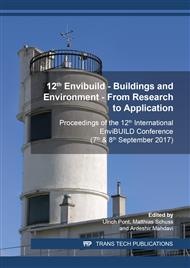p.597
p.605
p.613
p.622
p.633
p.641
p.650
p.659
p.667
Efficiency Increase of Solar Heated Buildings by Thermal Activation of Construction Elements
Abstract:
The Austrian project “solSPONGEhigh” [1] examines the use of thermal activation of building components in order to increase the solar fraction of the heat demand of buildings. The aim of the project is to evaluate, under which conditions a high solar fraction of a single family house (low energy building) can be achieved with solar technologies (PV and solar thermal, in this paper the focus is on solar thermal). Different heat supply systems based on solar thermal energy (basic or complex supply systems) have been defined. The systems were modeled in the simulation environment TRNSYS [2], analyzed concerning their system behavior and further developed. The investigated systems range from classical monovalent heat supply systems, systems combined with solar thermal up to complex integrated hydraulic solutions. The heating of the building via concrete core activation was compared with a conventional underfloor heating system. A detailed analysis of the dynamic system and building simulation results shows that the system efficiency can be significantly increased, if solar heat is used to charge the storage capacity of the building structure directly. A further advantage when activating the building structure (primarily concrete) is the less rapidly changing room air temperature with strongly fluctuating environmental conditions.
Info:
Periodical:
Pages:
659-666
Citation:
Online since:
January 2019
Price:
Сopyright:
© 2019 Trans Tech Publications Ltd. All Rights Reserved
Share:
Citation:


